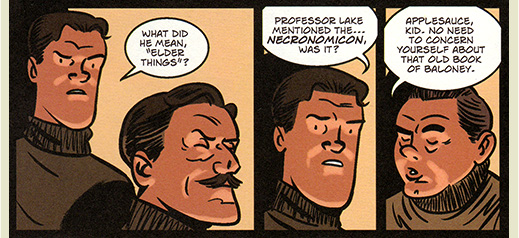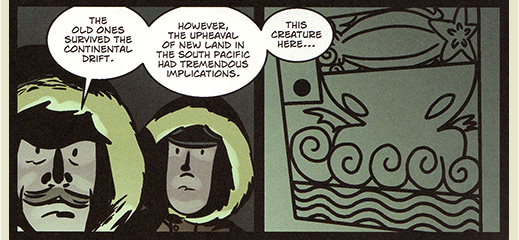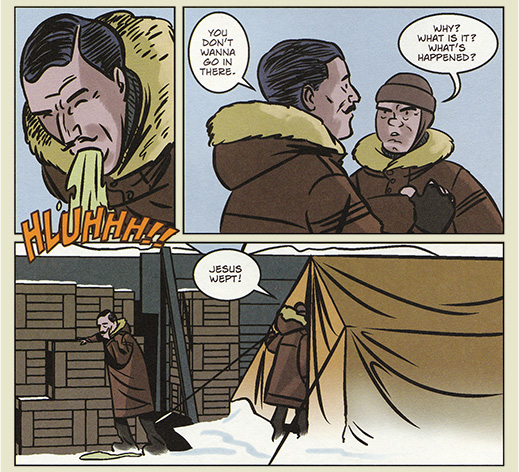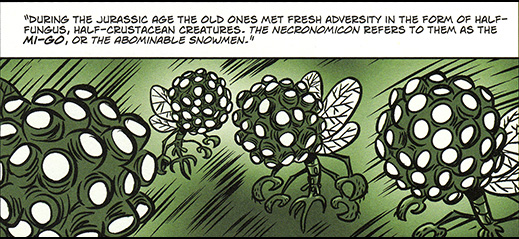At the Mountains of Madness
I've been a fan of H.P. Lovecraft for a while now. I mean, not a real fan. Real fans of the author would almost certainly consider me a dilettante—a lipstick Lovecraftian, if you will. Fact: I have never finished anything Lovecraft wrote. I gave At the Mountains of Madness a shot several years ago when I downloaded it for free for my old-gen Kindle. It was too slow, too dry, too far-removed to keep my interest.
What then are my points of contact with the author's worlds? Through Mignola's Hellboy universe, first of all. I know he hasn't adapted the Cthulhu mythos but I had read that his cosmic monstrosites have been described as Lovecraftian. And since I loved his monsters and elder gods and tentacle-beasts, I decided that I liked whoever was the influential genesis for these creations. My other point of entry is the boardgame, Arkham Horror, which is set in Lovecraft's fictional stomping ground and employs his creatures and mythos. Because of that game (which, sidenote, is really pretty fun), I can give a knowing nod of recognition when someone namedrops Cthulhu or Shoggoths or even Shub-Nigguroth the Black Goat of the Woods.
Unimpressive, I know. But here we all are.

With my previously abortive attempt to read "At the Mountains of Madness," I was pretty excited when I discovered that INJ Culbard had adapted the story into the comics medium. I loved Culbard's work adapting the Holmes mythos with Ian Edginton and thumbed appreciatively through his work in Princess of Mars last time I was in an actual, physical bookstore (sadly, only window shopping). At the least, I knew I could finish the story this time.
And I did. Culbard's attractive illustrations took me through a story that, while involving fascinating concepts, was actually pretty dull. The book has its up-sides for sure, but I'll hem and haw about where it went wrong for me before I get to the good stuff.
Because I found the original so distancing and tedious that I couldn't finish it, I don't have any viable apparatus to judge whether to blame Culbard or Lovecraft for what I feel went wrong here. I lean toward Lovecraft because 1) he's dead and won't have his feelings hurt, and 2) the opening to the original At the Mountains of Madness wasn't that encouraging on its own. The biggest issue may be that Culbard leans pretty heavily on dialogical and narrative-bubble exposition across the entire tale's expanse. As the story is related in flashback by a surviving member of an arctic expedition, this seems sensible and keeps the reader in mind that we're encountering the recent past in which something terrible occurred. Unfortunately the text is rather wooden and so, while fitting the standard style of desiccated academic writing (as all academic writing I've encountered is11It doesn't have to be of course, and I'll admit to only having read a smallish pile of academic papers.), is rather a chore to get through. It would have been nicer to see Culbard rely a bit more heavily on his artistic chops rather than on resurrecting so many of Lovecraft's words.22If indeed that is what he's done here. It would have been far more difficult, I imagine, to rely so much on art to tell this story but I believe both that Culbard is prodigious enough to do the work well and that the book would have been much more interesting for the effort.

Part of the issue, perhaps, is something I alluded to in my review of Junji Ito's horror classic Uzumaki. I begin that review wondering at the comics medium's ability to interact with the horror genre so well as other mediums:
I’m skeptical of comics’ power to truly horrify using supernatural elements. Because the reader controls entirely the pace of a story’s execution, one of the primary tools of the horror genre is kept from authors in the comics medium. Additionally, revulsion is increasingly difficult to elicit from static imagery—a gross drawing is merely that and draws forth none of that sense of fear or terror that aficionados of the genre tend to relish. Certainly a compelling story about the affects of war on a civilian population can horrify, but only because it is humanity who is the monster and not some lumbering creature of the imagination. There seems little room for the supernatural to scare us from the immobile, two-dimensional page.
This is Lovecraft. This is cosmic horror. We all know that because that's what we (even we who've never read the work) know about Lovecraft. Space monstrosities that push mortal men toward insanity. And yes, horrifying things happen. Supernatural things. Things beyond the ken of these men to describe. We are allowed to peek beneath the veil of a whole, horrifying world. Something that should be disturbing and frightening and maddening. Only it isn't.

I'd say the problem is that we are jaded by years and decades of being fed unnatural images through film and literature (because, of course, we have!), but this isn't the whole answer. After all, film and prose fiction still have the ability to conjure fear of the uncanny. So then it seems a weakness unique to the comics medium—and a weakness that diminishes the ability to empathize with the protagonists of At the Mountains of Madness, who are clearly terrified by the horror they've stumbled into. Rather than feel anything relevant to their revulsion or terror, I simply had to acquiesce to a detached acknowledgement that these people are feeling these things and that the events and beings they are witnessing are actually horrifying. I don't blame this on either Culbard or Lovecraft but the medium.33A lot of this is conjecture. I may be wrong and it may be that horror isn't impossible in the medium. It may be either that I haven't encountered the right book or story yet or it may simply be that I am dead inside and therefore incapable of feeling fear or horror or revulsion at any of these plainly terrifying things.
Okay, so those are my two complaints. Give them what weight you will. But instead now let's move on to the happier, gilded shores of Culbard's art.

The artist here presents page after page of lovely illustrations. His cartooning is top-notch and his skill at rendering his characters leaves nothing to be desired. The reason I was excited to see what he'd do for Mountains was that in the short time I've been following his work (two years? three?), it has yet to disappoint me. While his figures are straightforward and simply conceived, he spends some level of invention toward panel and page design. In the present work, it is not uncommon for him to expand one panel to fill the background and gutters of the entire two-page spread. It's a killer technique that lends an expansiveness to his pages.44I don't remember him doing this in prior works I've encountered but now I want to go back and see what I missed. The nature of Mountains' narrative gives Culbard numerous opportunities to experiment with lighting and he does a good job, dramatically illuminating subjects and casting demented shadows. The whole work is a visual treat.
In the end, Culbard saves me the trouble, allowing me to experience what I imagine is a faithful recreation of Lovecraft's novella. The story itself does little more for me than serve to sate my interest in the mythos sparked by experiences with tangential works. It was fun to encounter (in some sense of the word) Elder Things, Shoggoths, Mi-Gos, and Cthulhu. It was cool to hear mention of the history of R'lyeh and to learn a touch more of the civilization that once thrived on the Plateau of Leng. I only wished I could have been more enthralled by the experience. Man, that would have been something!
Good Ok Bad features reviews of comics, graphic novels, manga, et cetera using a rare and auspicious three-star rating system. Point systems are notoriously fiddly, so here it's been pared down to three simple possibilities:
3 Stars = Good
2 Stars = Ok
1 Star = Bad
I am Seth T. Hahne and these are my reviews.
Browse Reviews By
Other Features
- Best Books of the Year:
- Top 50 of 2024
- Top 50 of 2023
- Top 100 of 2020-22
- Top 75 of 2019
- Top 50 of 2018
- Top 75 of 2017
- Top 75 of 2016
- Top 75 of 2015
- Top 75 of 2014
- Top 35 of 2013
- Top 25 of 2012
- Top 10 of 2011
- Popular Sections:
- All-Time Top 500
- All the Boardgames I've Played
- All the Anime Series I've Seen
- All the Animated Films I've Seen
- Top 75 by Female Creators
- Kids Recommendations
- What I Read: A Reading Log
- Other Features:
- Bookclub Study Guides











